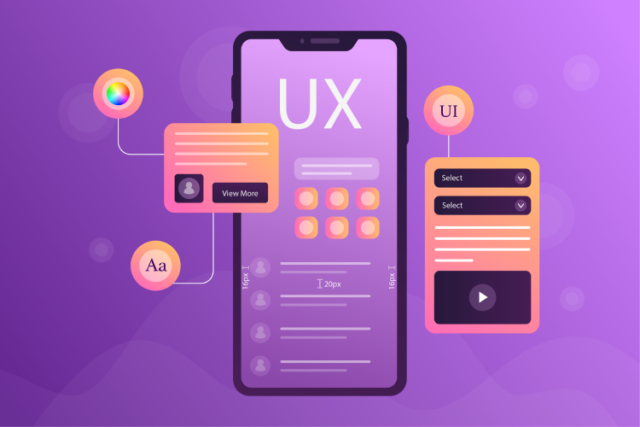
UI/UX design is a dynamic and creative field that helps to launch a good-looking, simple, and functional product everyone will like. In a modern competitive market, it is impossible to imagine a good or service that didn’t pass a UI/UX stage.
That is why, no matter whether you are an aspiring designer or a product owner, knowing UI/UX design principles is a competitive advantage. And we are happy to share 7 essentials that you can start using today.
User-Centric Approach

The word user is at the core of the UI/UX concept. It aims to solve any problems that users may face – whether it is poor design, low speed, or complex navigation. That is why UI/UX design trends always include the user-centricity concept. You should always put your customers’ needs first and make decisions based on the information collected.
It involves the age, gender, and location of the target audience, their main problems and desires. Some businesses are doomed to fail just because they neglected the research stage.
You should also dedicate enough time to user testing to see how well the audience meets your product and what aspects can be improved.
Hierarchy

A good UI/UX designer knows how important hierarchy is. It helps users move through the website, app, service, or product easily and is divided into information architecture and visual hierarchy.
The first one aims to organize the content to make it clear and understandable. Information architecture consists of the main menu, secondary menus, individual content parts, images, and videos.
Before you start filling the website or page with information, make sure to draw its supposed structure. Visual hierarchy helps users navigate a page more freely using larger headings, different fonts, interactive elements, and so on.
Consistency
Consistency is another element to work on throughout the UI/UX design process. It involves two different directions. First, your designs should feel and function similarly across all websites, screens, and platforms. This raises brand awareness and improves overall recognition. With a strong brand, it is much simpler to market your products.
Consistency also refers to meeting the audience’s needs. They already have their own expectations, so it is important to identify and satisfy them. Analyzing competitors and using some of their features is a great way to start. You shouldn’t copy them but there is no need to invent everything from scratch either.
Usability
Usability is a rather self-explanatory UI/UX principle that aims to make the product or service easy to use. If it is slow and complex, this means that your UI/UX designer should be fired. Usability involves multiple components but the main ones are learnability, effectiveness, and satisfaction.
First of all, it must be easy to get familiar with the product for the first time. Then, the service or product must quickly fulfil the customer’s needs. It should also be easy to re-familiarize with the good or website after not using it for a while.
Finally, the overall user experience should be satisfactory and pleasant. After placing the order, people should feel happy and not stressed.
Accessibility
The next element of UI/UX design we want to discuss is accessibility. It is crucial for the design process because aims to make the product or service accessible by all types of people not depending on their surroundings and circumstances. For example, high-colour contrast or audio versions of the text for people with visual impairments.
It is also a great idea to adjust your website to different devices: laptops, smartphones, tablets, and even wearables. Optimizing screens and reducing image sizes are only some of the main steps to make the website user-friendly. To go even further, hire developers to create a native app which will surely offer a great user experience.
Simplicity
It is a well-known fact that people need only up to 15 seconds to understand whether they want to stay on the website or not. That is why the design should be simple and clear, and show value from the very beginning. Here, the rule less is more takes on a special meaning.
When users scroll your website searching for the necessary information, there should be as few distractions as possible. Minimize content and buttons to help users take action. Plus, simple design helps the website load faster, decreases bounce rates, and boosts search engine optimization.
Responsiveness
The share of mobile traffic increases year after year, so when designing a website, you need to make sure that it is easy to read and use on any smartphone. Non-responsive website significantly increases the bounce rate. If people need to enlarge text on the screen to make it readable, they will eventually give up and choose another website.
Having a responsive website is not only about user experience. Google gives additional points to mobile-friendly websites which, in turn, leads to higher ranks in the search engines. Responsive websites load faster, look better, and are much simpler to maintain.
UX Practices that You Need to Implement Today

A combination of the principles mentioned above is the right way to a usable website that people would like to visit over and over again. And to make your strategy even better, here are the best user-experience practices. Write them out and check the list when working on your UX design:
- Establish UX routine and have a clear plan of action;
- Give much attention to the homepage. The book is often judged by its cover;
- Less is more;
- Make your website easily accessible on all devices;
- Conduct user testing throughout the design process;
- Clear navigation is crucial;
- Keep mobile users in mind;
- Work on product listings;
- Make check-outs fast and convenient.
Wrap-up
Although UI/UX design is based on tens or even hundreds of principles, starting with the 7 mentioned above is a great way to go. Always keep your users in mind, stick to hierarchy, be consistent, and make the product or service easy to use both on computers and smartphones. And if you struggle on any part of the journey, just hire an experienced UI/UX team.












